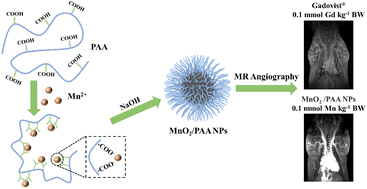Ultra-small manganese dioxide nanoparticles with high T1 relaxivity for magnetic resonance angiography†
Abstract
Gadolinium (Gd)-based contrast agents (CAs) for clinical magnetic resonance imaging are facing the problems of low longitudinal relaxivity (r1) and toxicity caused by gadolinium deposition. Manganese-based small molecule complexes and manganese oxide nanoparticles (MONs) are considered as potential alternatives to Gd-based CAs due to their better biocompatibility, but their relatively low r1 values and complicated synthesis routes slow down their clinical translation. Herein, we presented a facile one-step co-precipitation method to prepare MONs using poly(acrylic acid) (PAA) as a coating agent (MnO2/PAA NPs), which exhibited good biocompatibility and high r1 values. A series of MnO2/PAA NPs with different particle sizes were prepared and the relationship between the particle size and r1 was studied, revealing that the MnO2/PAA NPs with a particle size of 4.9 nm exhibited higher r1. The finally obtained MnO2/PAA NPs had a high r1 value (29.0 Mn mM−1 s−1) and a low r2/r1 ratio (1.8) at 1.5 T, resulting in a strong T1 contrast enhancement. In vivo magnetic resonance angiography with Sprague-Dawley (SD) rats further proved that the MnO2/PAA NPs showed better angiographic performance at low-dosage administration than commercial Gadovist® (Gd-DO3A-Butrol). Moreover, the MnO2/PAA NPs could be rapidly cleared out after imaging, which effectively minimized the toxic side effects. The MnO2/PAA NPs are promising candidates for MR imaging of vascular diseases.



 Please wait while we load your content...
Please wait while we load your content...